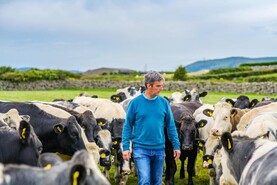High output dairy cows are metabolic athletes that require careful management throughout both the dry and lactating periods, farmers attending last Tuesday’s dairy conference organised by AgriSearch in Armagh were told.
“It is a consistent attention to detail on absolutely everything, all the time,” said Donaghcloney farmer Claire Beckett, who was among the main speakers at the event.
Claire who works two days per week as an animal nutritionist with Trouw Nutrition, farms in partnership with her parents, John and Karen, milking 150 cows on 210 acres. Average yield is 10,900l at 4.30% butterfat and 3.35% protein on twice per day milking. The herd is gradually being moved to a tight autumn calving block.
A firm believer in collecting data and assessing performance against target, Claire outlined various key performance indicators (KPIs) for her herd, as shown in Table 1. In particular, she looks at Income Over Feed Cost and lifetime daily yield. “Above £9 and above 20l, you are probably running a sustainable business,” she said.
To achieve those targets requires careful management through the dry period. Getting it right means avoidance of issues such as milk fever, which is a “gateway disease” to a lot of other health-related issues, said Claire.
The key to a dry cow diet on the Beckett farm is a low-potassium silage, made from swards that are headed-out and which receive nitrogen and no slurry.
That focus on potassium is all linked to Dietary Cation Anion Balance (DCAB), which is the balance of cations (potassium and sodium) to anions (sulphur and chloride). Cations increase blood pH and the risk of milk fever.
If low potassium silage is not available and dry cows are outside, Claire said they should be grazing standing hay.
“If you are grazing and holding tight, you are hitting rumen fill. You want the rumen to be filled. Don’t overfeed energy and keep the rumen expanded”, she said.
In the three weeks pre-calving, cows on the Beckett farm receive 20 to 25kg of dry cow silage, 3-4kg of chopped straw and 3-4kg of a high protein (28%) blend.
Lactation diet
Milking cows currently receive a mix of grass silage, maize silage, plus 10kg of blend and 4kg of a parlour nut.
The aim is to take first cut at the start of May and cut again at five-week intervals beyond that. All cows are currently housed, however, once settled in calf, lower yielders are grazed, probably starting in May.
The latest fertility data show very high performance is being achieved, with a calving index of 367 days, 92% of the herd pregnant by 130 days, 1.7 services to conception and a 59% conception rate.
“I put it all down to getting the transition cow right,” said Claire.






 This is a subscriber-only article
This is a subscriber-only article












SHARING OPTIONS: